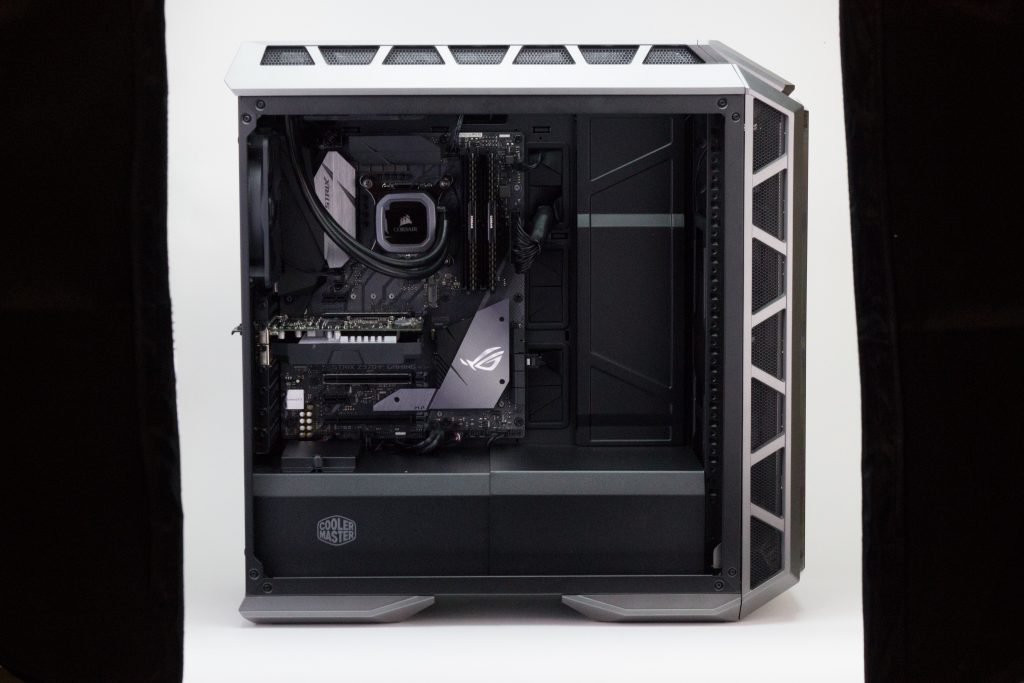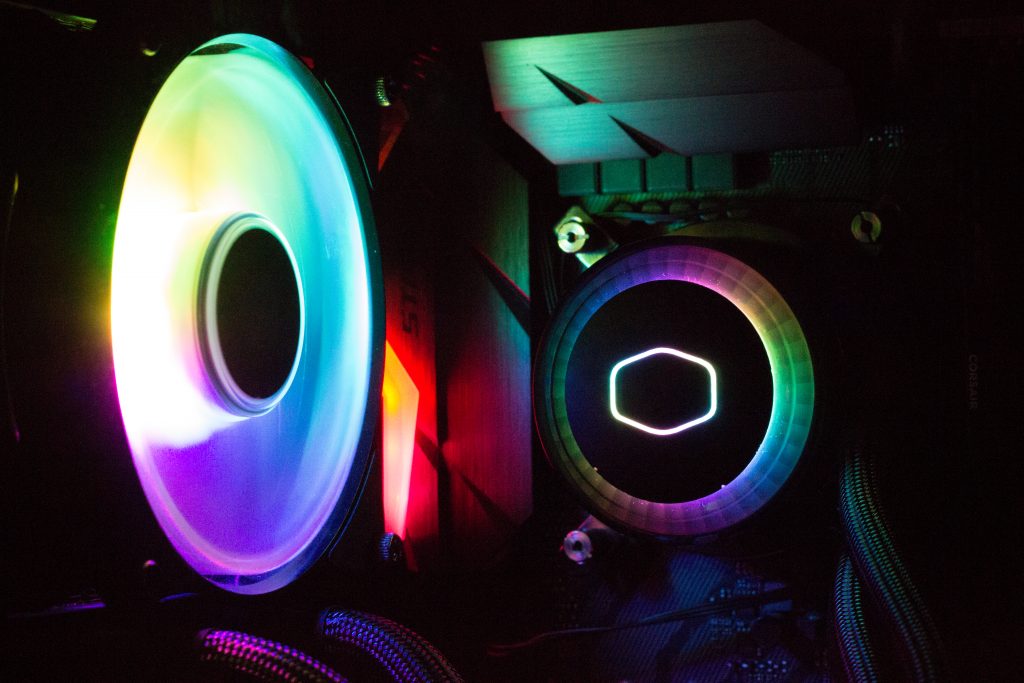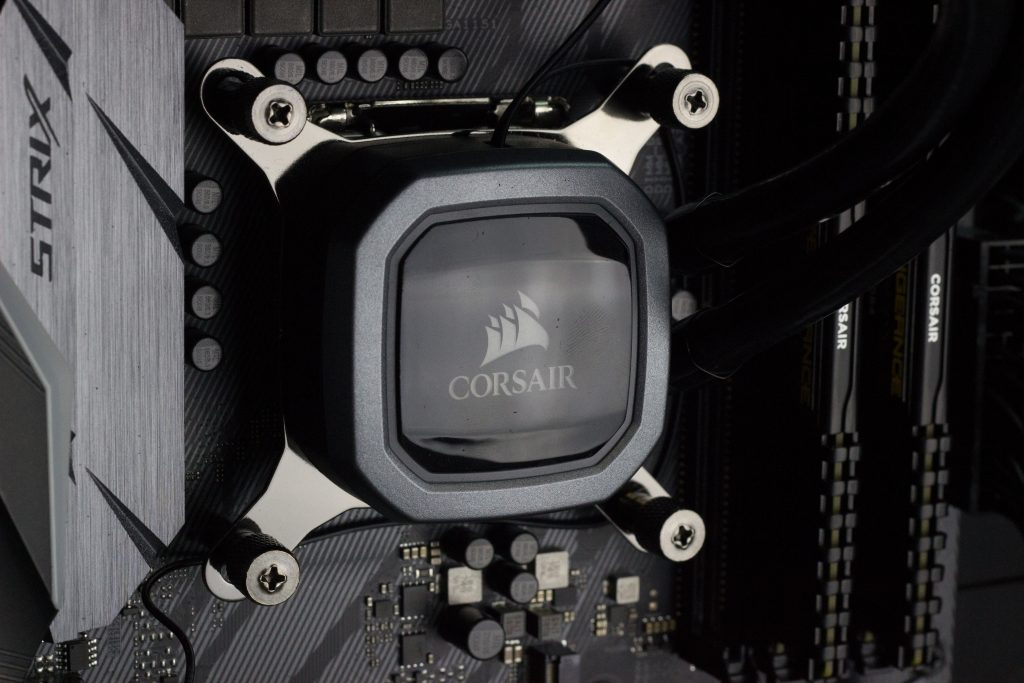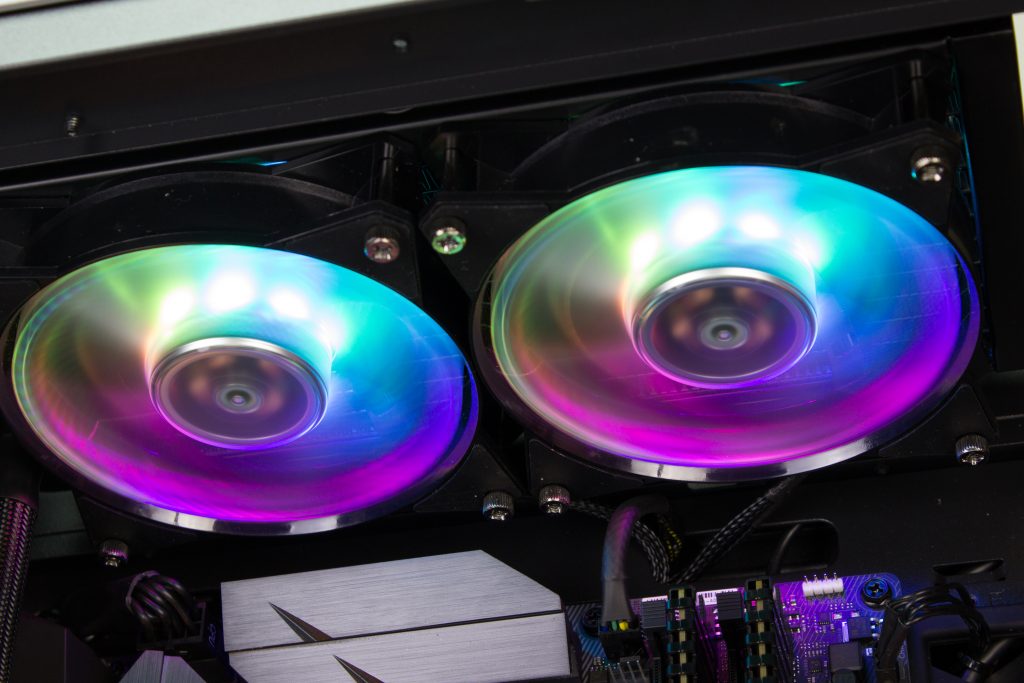We have written lots of CPU Cooler reviews over the past few months, all of which were in anticipation of this overall roundup article where we will compare all of our findings from the other articles, and directly compare them against each other.
Before we start, I'd like to thank Corsair, CoolerMaster and be quiet! for sending over the review samples of the coolers, making this whole group of articles possible.
In this round up we will be comparing all of the closed loop all in one coolers, the contenders are as follows:
Corsair Hydro Series™ H115i Pro RGB
Corsair Hydro Series™ H150i Pro RGB
CoolerMaster MasterLiquid Lite 120
CoolerMaster MasterLiquid Lite 240
All above links also link directly to our specific reviews, which contain more specific information and data regarding the specific AIO.
We will be comparing not only the performance of the AIOs, but also the aesthetics, additional features, included fans, mounting and noise levels.
Performance
Let's start with the most important bit, the performance numbers. We did do a lot of different tests on all of the AIOs, but found one test to be far better to best compare all of the different coolers. This test was Prime95 with the Blend Preset which is an AVX load and pushes the CPU to it's limits. We ran this test with both stock clocks and voltages, and also overclocked. The overclocked settings were 5.0GHz at 1.35v, in the results these tests are marked with "OC".
All AIOs were installed in the top of our test system, including 120mm variants that you may normally mount elsewhere, with the fans in the manufacturer recommended layout.

Test System Specs
- Processor - Intel i7 8700k
- Case - CoolerMaster H500P
- RAM - Corsair Vengeance DDR4 16GB 3000Mhz (2x8)
- Motherboard - Asus Rog Strix Z370-F
- SSD - Samsung 860 EVO 250GB
- PSU - Corsair RM750x
- GPU - EVGA GTX 1050Ti
Looking at this graph, there are definitely some clear winners and some results that were slightly disappointing as we expected much better results.
CoolerMaster MasterLiquid Lite 120
At the time of writing this review, this AIO can be bought for the ridiculously low price of £37.99, the same price of a mid range air cooler, which is fantastic for a closed loop liquid cooler. As expected, this did perform the worst out of all the coolers we tested, but it was not as far off as we thought it might be. The impressive stat comparison is the difference between the £37.99 MasterLiquid Lite 120 and the £59.99 with the exact same temperature results in the stock tests, and 4C difference in the overclocked testing. Whilst it gave the worst results out of all of the coolers 77°C for a 5GHz 8700K is still a very good average temperature and well within acceptable levels.
CoolerMaster MasterLiquid Lite 240
Not really much to mention about this one, aside from it being almost exactly the same as the MasterLiquid Lite 120 in terms of performance, which was somewhat unexpected due to the radiator being double the size. We suspect the flow rate of the fluid is the limiting factor which would explain why the extra radiator surface area doesn't do much for performance.
Corsair Hydro Series H60
The H60 performed exactly where we would expect it, slap bang in the middle of the other two 120mm AIOs we tested. In the overclocked tests it performed exactly the same as the CoolerMaster ML120R which is priced slightly higher, and in the stock tests it performed the same as both the MasterLiquid Lite 120 and 240.
CoolerMaster ML120R
So, for a 120mm AIO it is safe to say that this little cooler performs very well! It outperformed the Corsair H60 by a few degrees in the overclocked testing, which is probably due to the extra fan advantage the ML120R has. It also performed better than CoolerMaster's budget 240mm radiator AIO, but note that it is more expensive than both the MasterLiquid Lite 240 and the Corsair H60. This price increase is understandable however due to the mountains of RGB and other aesthetic upgrades it has over the two we are comparing it to.
CoolerMaster ML240R
A decent jump in performance from the 120mm variant on this one, which is good to see as it shows that the pump used is more powerful than it needs to be. You can see it sits nicely between the smaller ML120R and the Corsair H100X which is also a 240mm AIO, this is about where we expected it to be in terms of performance.
Corsair Hydro Series H100X
Another one that performed very well was the Corsair Hydro Series H100X which can be purchased for under £70 at the time of writing this article. In the stock tests the cooler performed exactly the same as the H115i Pro, with it's a 280mm radiator and the Asetek gen 5 pump, which is a very impressive result from the "little" 240mm radiator on the H100X. In the overclocked tests it was slightly behind but mostly within margin of error when put against the H115i Pro.
Corsair Hydro Series H115i Pro RGB
This is one of two AIOs we tested that used a 280mm radiator, and comparing it against the be quiet! Silent Loop 280 shows that it is isn't quite the best. However this cooler does pack in loads of other features that make it a decent buy at £132.99, more about those features later on. The interesting comparison is between the H115i Pro and the H150i Pro, in our testing it performed 1 degree worse than the H150i Pro in both the stock and overclocked tests, for a pretty huge £30 less.
Corsair Hydro Series H150i Pro RGB
Before we even had the AIOs out of the boxes, we were certain that Corsair's H150i Pro RGB with it's huge 360mm radiator would be the king of this article, which (spoiler alert) it absolutely is in some areas, but suprisingly not performance. It is outperformed in both the stock and overclocked testing by the be quiet! Silent Loop 280, which "only" sports a 280mm radiator. Even though it isn't at the very top, it's still one of the best performing AIOs out there and won't fail to tame any beast of an overclocked processor you put up against it.
be quiet! Silent Loop 280
Now these results were a little bit unexpected, we knew the combination of the copper radiator, decent fans & the size would equal some good performance, but to beat the Corsair H150i Pro with it's 360mm radiator and ML series fans??? Not to mention the 35% extra you'd pay for the H150i Pro.
So, if you only care about performance and your case can house a 280mm radiator then the be quiet! Silent Loop 280 is the correct choice. If you can only fit a 24omm radiator then we would recommend going with the Corsair Hydro Series H100x. And if you can only fit a 120mm radiator we recommend either the very cheap MasterLiquid Lite 120, or the Corsair Hydro Series H60 if you need that slight jump in performance.
Aesthetics
Aesthetics are probably the second most important thing when considering what AIO to buy for your loop, this doesn't have to mean RGB but also the other little bits that improve the look of an AIO, such as the tubing, radiators and fans. Some of the AIOs we tested are definitely designed with aesthetics in mind, and others are not so let's start with the ones that aren't.

CoolerMaster MasterLiquid Lite 120
This one doesn't really do much for us in terms of aesthetics, the tubing looks pretty bad, there are no LEDs in sight and the radiator doesn't look fantastic. However it is all black so will fit in to any build and not look out of place at all, which can't be said for some other AIOs on the market.
CoolerMaster MasterLiquid Lite 240
Exactly the same as the Lite 120, no need to go into any further detail.
Corsair Hydro Series H60
The H60 is fairly basic looking, but does have a few aesthetic features that make it stand out from some other AIOs we looked at. The main thing to talk about is the LED illumination that is on the CPU block, like the other Corsair AIOs this is not RGB but white instead. Another great aesthetic feature is the braided tubes that look much better than the rubber tubing that is exposed on some older Corsair AIOs, this braiding also offers a level of protection to kinks in the tubing.
Corsair Hydro Series H100x
The H100x is very similar in aesthetics to the H60, so it has the nice LED illumination on the CPU block and braided tubing which have the same benefits as they do on the H60.
be quiet! Silent Loop 280
Now it is very obvious that be quiet! weren't prioritising aesthetics at all when designing the Silent Loop 280. That being said, there are some parts of it that look fantastic. Every part of the AIO is black aside from the be quiet! branding on the CPU block and on the fans. Speaking of the CPU block, it is a simple design with the black plastic around the edges and the brushed aluminium top plate with the be quiet! logo nicely implemented into the top. Everything used to mount the CPU block is black too, including the bracket, springs and screws which adds to the stealthy look of the cooler. Oh and the single cable coming from the CPU block is braided in a nice black braid too.
There is one thing we do not like about the look of the cooler, and that is the anti-kink coils. They look very dated and aren't really too necessary, in fact the only other AIO we've seen with anti-kink coils is the Fractal Design Kelvin series, which are also made by Alphacool. If the tubing was braided like many of the popular AIOs nowadays we would not be able to fault the aesthetics of the Silent Loop 280, but overall be quiet! have done a fantastic job.
CoolerMaster ML120R
CoolerMaster definitely went all out when it comes to the aesthetics of the ML120R, this thing really does look fantastic. There are addressable RGB LEDs on the CPU Block and both fans, by using the splitter you can get all three zones synced up so the rotation of the LED effect is identical. The CPU block features the RGB illuminated CoolerMaster LOGO and a ring around the edge of the block. The fans have clear blades which are lit by LEDs in the center fan hub. We also like the braided tubing that the cooler has, this gives is a premium feel over a standard rubbed or plastic tubing.
One of the things we feel could use improvement is the fittings used to connect the tubing to the CPU block and radiator, these fittings are made of plastic and have a very cheap look and feel, we would much prefer to see these made of metal. Also, I feel that the fans and plastic on the CPU block do look and feel a bit cheap.
CoolerMaster ML240R
The only difference between the ML120R and the ML240R is the radiator size, so the above can be said about the ML240R too!
Corsair Hydro Series H150i Pro RGB
Corsair probably have the best looking AIO with the H150i Pro RGB(and other i Pro RGB). You can trust Corsair to make a great looking AIO that tastefully implements RGB, which is exactly what they've done on the H150i Pro RGB. Infact, it looks so good there isn't anything I'd change on it. The CPU block is where all of the RGB is going on, with an illuminated Corsair logo and a two diffused accent pieces around it. There is also a silvery piece breaking up the two RGB accents which looks fantastic.
The tubing is also something to rave about, not only is it very flexible and doesn't kink making it very easy to install, it also looks amazing as it is sheathed in some sexy black braiding. The radiator continues the trend of how great this cooler looks, with a sleek squared off design sporting a metal Corsair logo nicely placed in the centre of the radiator.
Corsair Hydro Series H115i Pro RGB
This one has all the same aesthetic features as the H150i pro RGB, the only difference being the radiator size and fan size.
So the clear winner here are the two AIOs from Corsair's "i Pro RGB" line, with an hourouable mention to the CoolerMaster ML coolers we tested.
Mounting
We think ease of installation is a very important thing for any CPU cooler to have, what good is a cooler if it's just sitting in the box because you can't install it? Luckily, over the past few years mounting has evolved very well and nobody really gets it that wrong.

All CoolerMaster AIOs
So, we tested four different CoolerMaster AIOs and they all use exactly the same mounting system.
The mounting of the CPU block, fans and radiator is pretty easy. You start by assembling the backplate with four bolts and four plastic caps to hold the bolts in place, this whole assembly them goes through the motherboard which the cooler can be screwed down onto using the included bolts.
The radiator placement is also very easy compared to other AIOs, this is because the pump is located in the CPU block itself and not on the side of the radiator, making the radiator considerably smaller therefore easier to fit! The bolts that come with the cooler are fantastic, they are a standard M4 bolt but one end has a thumb screw part that also has an M4 threaded hole, allowing you to screw something else into it, making almost any fan configuration imaginable possible.
All Corsair AIOs
All the Corsair AIOs we tested also use the standard Asetek mounting, which is fairly simple to install and in our opinion easier than the CoolerMaster mounting.
The tool-less mounting makes installation very easy, the interchangeable mounting brackets on the CPU block is very simple to install and has been improved over the already great Asetek gen 5 design. The rest of the mounting is almost identical to older Corsair AIOs, where you screw standoffs through the board into the backplate. This method makes uninstalling and reinstalling of the cooler very
The radiator is also very easy to position due to the flexibility of the tubing, which doesn't seem to kink easily at all which is nice to see. The included screws for the radiator are the perfect length for all configurations.
The tubing routes out of the side of the CPU block which we think looks much nicer than the older straight out of the top design used previously, we also didn't have any issues with RAM clearance on an 115x socket with Corsair LPX DDR4 RAM.
be quiet! Silent Loop 280
The be quiet! Silent Loop 280 is very easy to install, you start by assembling the mounting hardware around the CPU block, which then screws through the motherboard into the included backplate. Screwing fans to a radiator can be a recipe for disaster, if you screw too far into the radiator you risk puncturing the internal channels, causing a leak. The Silent Loop 280 has a fantastic feature that completely eliminates this risk, by simply having metal tabs underneath the screw holes so it isn't possible to screw in too far as the screws would just bottom out on the metal tabs. It also helps that the screws that are included are the perfect length for any fan layout (push/pull etc).
The final step in the mounting is screwing the radiator to your case, due to this being a 280mm radiator there are compatibility issues with some cases, so make sure to check your case does support a 280mm radiator before buying this AIO! The tubing also makes the radiator placement very easy as it is more flexible than other AIOs, and has anti-kink coils so you are able to have the tubing at tighter angles without issue.
A good conclusion to this part of the article is to say that all of the AIOs we tested were more than acceptable, and the mounting shouldn't really be a reason to choose and AIO over another.
Fans
In this section of the article I will compare the fans that are included with the AIOs, including comparisons of the manufacturer specified noise levels and airflow.

The graph below is comparing the CFM of the fans that are included with the AIOs
These numbers are quite surprising, with CoolerMaster coming out on top with all of their AIOs that we tested. The be quiet! Silent Loop 280 is also a great performer with 61.2CFM. These numbers aren't really worth anything withouth comparison against the noise levels, so below is a graph comparing the noise level of the fans at 100% speed, which is obviously different for each fan.
Now we can see why the CoolerMaster fans have so much air flow, they definitely aren't the quietest we tested but are still in an acceptable noise range, even if they can be a bit whiny at higher RPMs (which we've only ever seen hit on the MasterLiquid Lite 120). The Corsair SP series fans included in the H100x and H60 are pretty bad compared to the others in the list, which is one of the downsides we mentioned in the standalone articles.
The outright winner here is the be quiet! Pure Wings 140mm fans included on the Silent Loop 280, to be top of the dBA graph is impressive, but to also be in 2nd place on the CFM graph too?! be quiet! have done a fantastic job with the fans on this AIO.
It's worth an honorable mention to the ML series fans on the H150i and H115i from Corsair, these are both very quiet and perform very well.
Other Features
Now we can compare the basic features like noise, performance, fans and aesthetics all day long but sometimes it's a unique feature that really makes an AIO worth buying. In this section of the article I will outline these unique features.
be quiet! Silent Loop 280
So this isn't a huge "feature", but it is the reason why the Silent Loop 280 performs so well, even compared to the Corsair H150i with it's much bigger 360mm radiator. The Silent Loop 280 uses a copper radiator and a much better pump that an AIO usually would, this is because it is actually made by Alphacool for be quiet! based off their expandable AIO and radiators used for full custom loops. This means the tier of hardware is much higher, along with the performance being much higher.
Corsair Hydro Series H150i Pro RGB/ H115i Pro RGB
The software is something Corsair have really improved recently with the launch of iCue, there are some very impressive things that you can do with this AIO. The most impressive being the 0RPM mode, where the fans won't spin until the coolant temperature hits 45c. You can sync up your fan profiles with other temperatures, including the coolant temperature which is something that we haven't seen from other Corsair AIOs previously. This option is great because it gets rid of that horrible burst of fan noise when the CPU temperature spikes with other AIOs.
Conclusion
This is the part where we outline the clear winners and any further honorable mentions that deserve the credit.
First of all let's start with our clear winner, the be quiet! Silent Loop 280. There really isn't much (aside from the pretty bad anti-kink coils) that could be improved on this AIO, is has fantastic performance, a very simple mounting mechanism, great looks and a couple of very good fans, all for a pretty low figure of £120. No it doesn't have any fancy RGB, but still looks tasteful with the all black aesthetic meaning it would fit nicely into any build.
Another winner for us is the MasterLiquid Lite 120. Yes, it was at the bottom of the list in most of our tests but the price is what makes it. We have never seen an AIO from a reputable manufacturer for under £40 before, and what this little thing brings to the table is very impressive, so impressive that it is the entry level AIO that is now an option to select on most of our fantastic PCs.
The Corsair H100x is also a winner in the same way that the MasterLiquid Lite 120 is, obviously the H100x is in a higher tier than the Lite 120 but it still is a fantastic cooler for the price. Historically the Corsair H100 coolers have been more expensive than competitors, but Corsair have done a good job to get the H100X to market with an MSRP of £84.99.
It's worth giving an honorable mention to the Corsair H150i Pro RGB and H115i Pro RGB which are two fantastic coolers that offer great performance, fantastic software, incredible aesthetics and an easy mounting system for a fairly reasonable cost.


